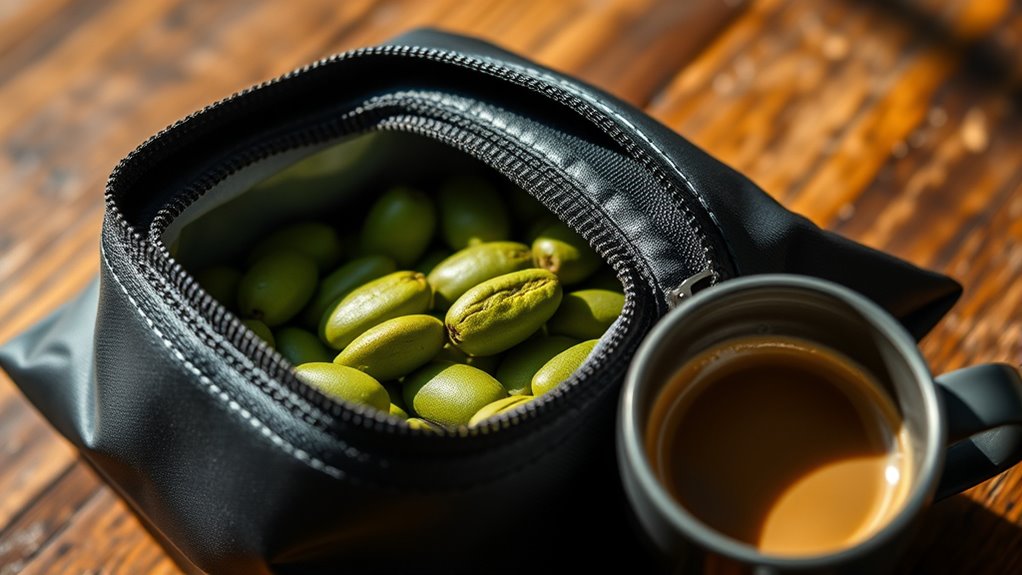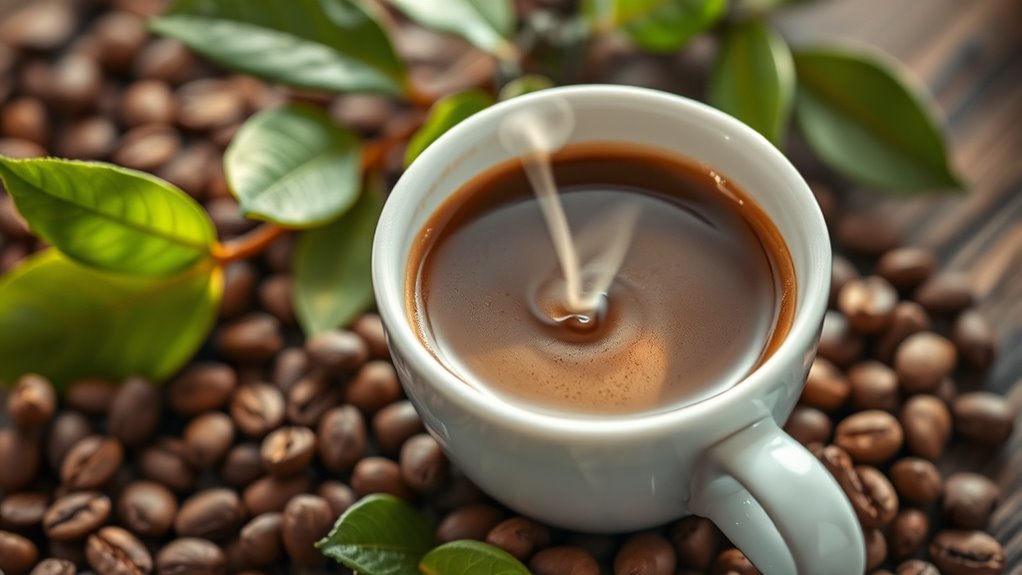Freshness matters in coffee taste because it directly affects the flavor and aroma you experience. Coffee beans lose their vibrant profiles shortly after roasting, with peak flavors occurring between 7 to 21 days post-roast. The degassing process also plays an essential role—too soon after roasting, and you’ll miss out on rich flavors. To truly enjoy your cup, you should focus on buying and brewing fresh coffee. Keep going to discover effective ways to maintain that freshness!
Key Takeaways
- Freshness significantly influences flavor and aroma, with peak taste occurring 7 to 21 days after roasting.
- Up to 70% of aromatic compounds can degrade within eight days, highlighting the importance of consuming coffee quickly.
- Grinding coffee just before brewing helps preserve flavor integrity and reduces exposure to air.
- Proper storage methods, like using airtight containers, are essential for maintaining coffee freshness.
- Engaging the senses can help identify freshness; vibrant smells and tastes indicate high-quality, fresh coffee.
The Science of Coffee Freshness

When you brew a cup of coffee, the freshness of the beans directly impacts the flavor and aroma you experience.
Freshly roasted coffee retains its vibrant flavors for about 4 to 6 weeks, with some varieties lasting up to two months. The degassing process, where coffee beans release carbon dioxide after roasting, is essential; insufficient degassing can lead to staleness and off-flavors.
Ideally, you should consume whole bean coffee within 7 to 21 days post-roast for the best taste. Proper storage practices, like using bags with one-way valves, help maintain freshness by allowing gas release while preventing air entry.
This way, you can enjoy the rich aroma of the coffee while savoring its full, delightful flavors.
How Freshness Affects Flavor and Aroma

Freshness plays a critical role in shaping the flavor and aroma of your coffee, as the complex interplay of over 800 individual flavor compounds begins to deteriorate soon after roasting.
Freshly roasted coffee reaches its peak flavor between 7 to 21 days post-roast. After that, you could lose up to 70% of aromatic compounds within just eight days.
Freshly roasted coffee is best enjoyed within 7 to 21 days, as flavor diminishes rapidly thereafter.
To enjoy the best taste and aroma, always grind your roasted coffee beans just before brewing; ground coffee off-gasses quickly, further diminishing flavor.
Additionally, proper storage techniques, like using airtight containers and keeping your coffee in cool, dark places, are essential for preserving the flavor and ensuring your cup remains vibrant and delightful. Furthermore, coffee consumption can be influenced by global coffee culture, which highlights the diverse ways people appreciate and enjoy this beloved beverage.
Key Strategies for Maintaining Coffee Freshness

To keep your coffee fresh and flavorful, start by buying smaller quantities that you’ll use within a week.
Grinding your beans just before brewing locks in the aroma and taste that can fade quickly once ground.
Finally, store your coffee in airtight containers to shield it from light and air, ensuring every cup remains vibrant.
Purchase Smaller Quantities
Purchasing coffee in smaller quantities can greatly enhance your brewing experience and preserve the vibrant flavors that make each cup special. Fresh coffee is best enjoyed within two weeks of roasting, so aim for about a week’s worth of beans. This strategy helps maintain the freshness of the beans and prevents oxidation, which can diminish flavor.
| Freshness of Beans | Maximum Number of Days |
|---|---|
| Fresh Coffee | 14 |
| Older Coffee | 8 |
| Flavor Deterioration | 70% |
Grind Just Before Brewing
Grinding coffee just before brewing is one of the simplest yet most effective ways to maintain its freshness. When you grind just before brewing, you minimize exposure to air, which accelerates oxidation and the loss of flavors and aromas.
Whole bean coffee retains more flavorful oils, so grinding only what you need guarantees you enjoy the best taste. Freshly ground coffee releases aromatic compounds that greatly enhance your cup’s flavor profile.
Remember, the ideal consumption window for coffee is between 7 to 21 days post-roast, and grinding right before brewing helps preserve the freshness of your coffee during this period.
Store in Airtight Containers
After you’ve enjoyed the rich flavors of freshly ground coffee, storing the remaining beans properly becomes vital for maintaining their quality. Using airtight containers is essential for preserving freshness. These containers limit exposure to air, which can cause oxidation and diminish flavor over time. They also protect your coffee from moisture and strong odors, ensuring a vibrant taste. Additionally, keeping your beans fresh will help retain their caffeine content, allowing for a more enjoyable coffee experience.
| Container Type | Benefits |
|---|---|
| Ceramic | Prevents moisture absorption |
| Glass | Non-reactive, easy visibility |
| Stainless Steel | Durable and airtight |
| One-way Valve Bags | Releases carbon dioxide |
Understanding the Ideal Freshness Timeline

To enjoy the full spectrum of coffee’s flavor, it’s essential to understand its freshness timeline.
Right after roasting, your coffee needs time to degas, which is vital for preserving its taste.
Aim to brew your coffee within 7 to 21 days post-roasting for the best experience.
Degassing Process Explained
Understanding the degassing process is crucial for enjoying the full spectrum of coffee flavors. After coffee beans are roasted, they release carbon dioxide, which can impact taste if brewed too soon.
The ideal consumption window is between 7 to 21 days after roasting. During this time, the beans degas adequately, allowing the freshest coffee to shine. If you brew too early, high carbon dioxide levels can lead to undesirable flavors.
Light roasts typically require less degassing time compared to dark roasts, so pay attention to the roasting process. Properly balancing the degassing process guarantees your Specialty Coffee offers a richer, more enjoyable experience while preserving its vibrant flavors.
Prioritizing coffee freshness is key to savoring every cup.
Optimal Brewing Window
The timeline for enjoying your coffee at its peak is vital to experiencing its full flavor profile. You’ll want to brew your coffee between 7 to 21 days after roasting. This ideal brewing window is essential for maintaining the full spectrum of flavors.
Freshly roasted coffee beans release carbon dioxide during degassing, and brewing too soon can lead to undesirable tastes. After just eight days, some aromatic compounds can degrade by up to 70%.
While you can still drink coffee up to 30 days post-roast, the flavors may become blunt or faded. Remember, the surface area of your coffee grounds and how you store that bag of freshly roasted beans are also important factors in preserving flavor.
The Role of Packaging in Preserving Freshness

While you might savor the rich flavors of fresh coffee, preserving that taste hinges greatly on effective packaging.
You need to understand the importance of how packaging plays a vital role in maintaining the freshness of roasted beans. Innovative techniques, like resealable bags with one-way valves, allow gases to escape while blocking out light and air, which are key factors in the staling process.
Proper packaging minimizes exposure to moisture, markedly extending the shelf life of your coffee. Brew Factory emphasizes this process from roasting to cup, ensuring vibrant flavors and delightful aromas stay locked in until you brew.
With the right packaging, you can enjoy your coffee at its best, cup after cup.
Tips for Proper Coffee Storage and Evaluation

To keep your coffee tasting its best, proper storage and evaluation are key. Follow these tips to help maintain freshness:
| Storage Tips | Evaluation Tips |
|---|---|
| Keep coffee away from direct light. | Smell for rich aromas. |
| Store in a dry place, ideally between 50°F to 70°F. | Taste for vibrant flavors. |
| Use airtight containers for opened bags. | Observe the freshness of the beans. |
For unopened bags, keep them at room temperature. Engaging your senses is essential; fresh coffee will smell and taste amazing, while stale coffee will disappoint. Remember, Freshness Matters for every cup you brew! Additionally, fresh coffee is similar to freshly squeezed juices in that it retains more flavors and aromas when stored properly. Just like how tropical fruits enhance the taste of juices, fresh coffee beans can elevate your brewing experience. To further enhance your experience, consider pairing your coffee with frozen yogurt to enjoy a refreshing dessert. Brewing methods like French Press can also impact the overall flavor and freshness of your coffee.
Frequently Asked Questions
Why Does Coffee Taste Better Fresh?
Coffee tastes better fresh because it retains its vibrant flavors and aromas.
When you brew coffee within 7 to 21 days post-roast, you enjoy its peak taste, as the unique compounds that create flavor degrade over time.
Grinding your beans just before brewing further enhances freshness by minimizing oxidation.
If you expose coffee to air, light, or moisture, you’ll notice a decline in taste, making that fresh cup truly special.
Why Does Coffee Smell so Good but Taste so Bad?
Imagine walking into a bakery, the scent of fresh bread enveloping you.
Coffee’s aroma works similarly, enticing you with over 800 aromatic compounds. However, when you brew coffee too soon or use stale beans, the taste can fall flat, like biting into a dry loaf.
The delightful smell doesn’t guarantee flavor; it’s often the freshness that determines whether your coffee experience is heavenly or disappointing. Stale beans just can’t deliver that rich, satisfying flavor.
What Does Too Fresh Coffee Taste Like?
Too fresh coffee can taste sour or overly acidic, often leaving you disappointed.
When you brew it right after roasting, you might notice a flat flavor, lacking the vibrant complexity you expect. The high levels of carbon dioxide in the beans can overwhelm your palate, resulting in an imbalanced cup.
You’ll miss out on the richness and depth that develop after a proper resting period, making your coffee experience less enjoyable.
Why Does Restaurant Coffee Taste Better Than at Home?
You might think your home coffee is just as good as what you get at a restaurant, but there’s a big difference.
Restaurants often use freshly roasted beans and grind them right before brewing, which preserves those rich flavors. Plus, professional baristas know how to extract the best taste using precise techniques.
They also brew in larger batches, ensuring you get that coffee at its peak freshness—something home brewing can struggle to achieve.
Conclusion
In the world of coffee, freshness is your golden ticket to a symphony of flavors. Picture sipping a cup bursting with vibrant notes, where each sip dances on your palate like a warm breeze. By embracing the science of freshness and mastering storage techniques, you’re not just brewing coffee; you’re crafting an experience. So, keep those beans sealed tight and savor each moment, because nothing beats the thrill of a freshly brewed cup that tells a story in every drop.









